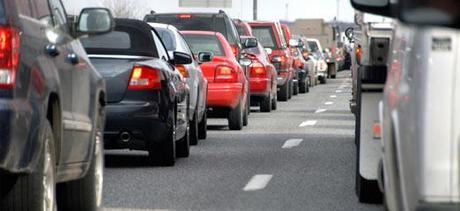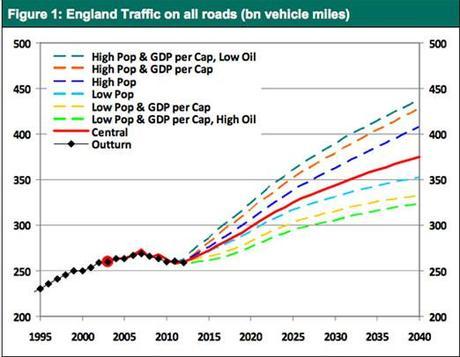
We’ve talked about the governments climate change goals several times on this blog, with policies such as CERT, ECO and the Green Deal designed to reduce the energy consumption of our homes.
With such a seemingly eco-friendly government, many are surprised to learn that the government want to increase the number of cars on the roads.
The following article originally appeared on the excellent Carbon Brief website.
You can read the original version here.
The government predicts road traffic will increase by two fifths by 2040 – and it’s banning planners from taking climate change into account when deciding whether new roads should be built. The government argues this won’t affect plans to cut greenhouse gas emissions from the sector, but it hasn’t justified its position.
Last June, chancellor George Osborne announced the ” largest programme of investment in our roads for half a century”. The government is going to plow £50 billion into the country’s roads, remedying decades of underinvestment, it says.
The government wants to increase road capacity as the UK’s population and economy expands over the next few decades. Campaign group, the campaign for better transport, disagrees. It says the government is ” outrageously” ignoring its climate commitments, in order to press ahead with road expansion.
The government’s plans for road expansion
The following graph, taken from a government document, illustrates planned traffic growth over the next few decades. The coloured lines illustrate differing levels of growth, dependent on what happens to the country’s economy and population:

Road transport forecasts 2013. Department for transport. In its central case (the red line), traffic increases by 42 per cent between 2010 and 2040.
There’s an obvious tension here between the government’s commitment to increasing road travel, and cutting greenhouse gas emissions. Road and rail travel currently account for about a fifth of the UK’s carbon emissions. Government advisor the Committee on Climate Change (CCC) suggests surface transport emissions – emissions from cars, vans and trains – need to reduce by 40 per cent between 2010 and 2030, if the government is going to hit its targets under the climate change act.
The government predicts transport emissions will fall until 2030, and then rise again as demand increases. The committee tells us its modeling only goes up to 2030, so it can’t say whether a 40 per cent increase in traffic by 2040 is compatible with the government’s climate targets, or not.
The government also says road developments will have a ” very small” impact on the country’s emissions. But it doesn’t explain how it works this out.
Achieving emissions cuts
Local planners could take the emissions-impacts of new roads into account when making decisions as to whether individual roads should go ahead or not. The CCC appears to support this approach. It says:
“it is important that transport emissions are factored into planning decisions alongside other costs and benefits.”
In its draft plans, the Department for Transport (DfT) explicitly forbids this approach, however. It says “while individual [road] schemes may result in an increase in carbon emissions”, planners should not take climate emissions into account when making decisions.
The DfT takes this position because it believes its carbon plan will ensure emissions go down. In other words, it argues its policies aimed at reducing carbon emissions elsewhere will offset the increase in carbon from new roads.
Saved by efficient cars?
The transport section of the carbon plan explains how the government intends to cut emissions from the transport sector. Over the next decade, it says it will focus on the “easy wins” in surface transport – incentivising more efficient car engines and the use of sustainable biofuels as fuel.
In the 2020s, the document says “we will move towards the mass market roll-out of ULEVs [ultra low emission vehicles]” – vehicles powered by batteries, hydrogen fuel cells or sustainable biofuels.
There aren’t any numbers in the document showing how a 40 per cent increase in traffic will be squared with emissions reductions, but the government appears to be arguing ULEVs will play a major part in fixing the problem. According to this argument, it can dramatically increase the number of vehicles on the road without increasing carbon emissions.
This creates two possible problems, however. First, takeup of ULEVs may not proceed as rapidly as the government claims. Professor Jillian Anable, an expert on transport and climate change from the university of Aberdeen, tells Carbon Brief the government’s predictions for the rate at which ULEVs will expand is “really quite optimistic”. Decarbonisation of the car fleet by the middle of the century is “far, far from certain”, she adds.
Second, the government may need to tackle transport demand in addition to encouraging takeup of fuel-efficient cars, if it’s going to hit its climate change targets. The carbon plan mentions a few projects intended to encourage people travel less by car, but clearly doesn’t see this as a priority.
The CCC, which uses government modelling as the basis for its calculations, agrees car travel will go up by 2030, by about a fifth. But it also says voluntary reductions in car use – achieved through fewer trips, more travel by public transport, and more walking and cycling – could reduce car and van travel by five per cent by 2030, relative to what it would have been.
Locked into a car-dependent future
The government seems quite focused on expanding the country’s road network, however. In the DfT paper ‘ Action for Roads’, it argues the road network is “vital to our nation” and must be made “fit for the future”.
It says the government’s carbon plan will explain how the government can both dramatically increase the amount of traffic on the road and reduce emissions. It mainly appears to be relying on fuel efficient cars to achieve this.
But experts have doubts about whether this technological fix is the right approach. Professor Anable tells us:
“History tells us that road expansion generates more traffic, and more road use. If we build roads, but don’t manage to decarbonise car use, we could be in a worse place than before.”
Professor Anable argues that the government has a choice. It’s choosing to create a future in which we’re more and more dependent on cars. But the longer that goes on, the harder it is to reverse – and the more difficult, and expensive, it is to reduce transport emissions.
